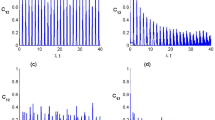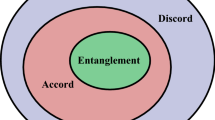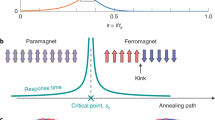Abstract
Quantum correlations are at the heart of quantum information science1,2,3. Their detection usually requires access to all the correlated subsystems4,5. However, in many realistic scenarios this is not feasible, as only some of the subsystems can be controlled and measured. Such cases can be treated as open quantum systems interacting with an inaccessible environment6. Initial system–environment correlations play a fundamental role for the dynamics of open quantum systems6,7,8,9. Following a recent proposal10,11, we exploit the impact of the correlations on the open-system dynamics to detect system–environment quantum correlations without accessing the environment. We use two degrees of freedom of a trapped ion to model an open system and its environment. The present method does not require any assumptions about the environment, the interaction or the initial state, and therefore provides a versatile tool for the study of quantum systems.
This is a preview of subscription content, access via your institution
Access options
Subscribe to this journal
Receive 12 print issues and online access
$259.00 per year
only $21.58 per issue
Buy this article
- Purchase on SpringerLink
- Instant access to full article PDF
Prices may be subject to local taxes which are calculated during checkout





Similar content being viewed by others
References
Horodecki, R., Horodecki, P., Horodecki, M. & Horodecki, K. Quantum entanglement. Rev. Mod. Phys. 81, 865–942 (2009).
Modi, K., Brodutch, A., Cable, H., Paterek, T. & Vedral, V. The classical-quantum boundary for correlations: Discord and related measures. Rev. Mod. Phys. 84, 1655–1707 (2012).
Nielsen, M. A. & Chuang, I. L. Quantum Computation and Quantum Information (Cambridge Univ. Press, 2000).
Auccaise, R. et al. Experimentally witnessing the quantumness of correlations. Phys. Rev. Lett. 107, 070501 (2011).
Silva, I. A. et al. Measuring bipartite quantum correlations of an unknown state. Phys. Rev. Lett. 110, 140501 (2013).
Breuer, H-P. & Petruccione, F. The Theory of Open Quantum Systems (Oxford Univ. Press, 2007).
Pechukas, P. Reduced dynamics need not be completely positive. Phys. Rev. Lett. 73, 1060–1062 (1994).
Lindblad, G. On the existence of quantum subdynamics. J. Phys. A 29, 4197–4207 (1996).
Laine, E-M., Piilo, J. & Breuer, H-P. Witness for initial system–environment correlations in open-system dynamics. Europhys. Lett. 92, 60010 (2010).
Gessner, M. & Breuer, H-P. Detecting nonclassical system–environment correlations by local operations. Phys. Rev. Lett. 107, 180402 (2011).
Gessner, M. & Breuer, H-P. Local witness for bipartite quantum discord. Phys. Rev. A 87, 042107 (2013).
Myatt, C. J. et al. Decoherence of quantum superpositions through coupling to engineered reservoirs. Nature 403, 269–273 (2000).
Schindler, P. et al. Quantum simulation of dynamical maps with trapped ions. Nature Phys. 9, 361–367 (2013).
Blatt, R. & Roos, C. F. Quantum simulations with trapped ions. Nature Phys. 8, 277–284 (2012).
Osterloh, A., Amico, L., Falci, G. & Fazio, R. Scaling of entanglement close to a quantum phase transition. Nature 416, 608–610 (2002).
Dillenschneider, R. Quantum discord and quantum phase transition in spin chains. Phys. Rev. B 78, 224413 (2008).
Häffner, H., Roos, C. F. & Blatt, R. Quantum computing with trapped ions. Phys. Rep. 469, 155–203 (2008).
Mintert, F., de Carvalho, A. R. R., Kus, M. & Buchleitner, A. Measures and dynamics of entangled states. Phys. Rep. 415, 207–259 (2005).
Weitenberg, C. et al. Single-spin addressing in an atomic Mott insulator. Nature 471, 319–324 (2011).
Li, C. F., Tang, J-S., Li, Y-L. & Guo, G-C. Experimentally witnessing the initial correlation between an open quantum system and its environment. Phys. Rev. A 83, 064102 (2011).
Smirne, A., Brivio, D., Cialdi, S., Vacchini, B. & Paris, M. G. A. Experimental investigation of initial system–environment correlations via trace-distance evolution. Phys. Rev. A 84, 032112 (2011).
Breuer, H-P., Laine, E-M. & Piilo, J. Measure for the degree of non-Markovian behavior of quantum processes in open systems. Phys. Rev. Lett. 103, 210401 (2009).
Rivas, A., Huelga, S. F. & Plenio, M. B. Entanglement and non-Markovianity of quantum evolutions. Phys. Rev. Lett. 105, 050403 (2010).
Liu, B-H. et al. Experimental control of the transition from Markovian to non-Markovian dynamics of open quantum systems. Nature Phys. 7, 931–934 (2011).
Lanyon, B. P., Barbieri, M., Almeida, M. P. & White, A. G. Experimental quantum computing without entanglement. Phys. Rev. Lett. 101, 200501 (2008).
Dakić, B. et al. Quantum discord as resource for remote state preparation. Nature Phys. 8, 666–670 (2012).
Leibfried, D., Blatt, R., Monroe, C. & Wineland, D. Quantum dynamics of single trapped ions. Rev. Mod. Phys. 75, 281–324 (2003).
Luo, S. Using measurement-induced disturbance to characterize correlations as classical or quantum. Phys. Rev. A 77, 022301 (2008).
Grabert, H., Schramm, P. & Ingold, G-L. Quantum Brownian motion: The functional integral approach. Phys. Rep. 168, 115–207 (1988).
Islam, R. et al. Emergence and frustration of magnetism withvariable-range interactions in a quantum simulator. Science 340, 583–587 (2013).
Acknowledgements
This work was supported by the NSF CAREER program grant # PHY 0955650. M.G. thanks the German National Academic Foundation for support. M.R. was supported by an award from the Department of Energy Office of Science Graduate Fellowship Program administered by ORISE-ORAU under Contract No. DE-AC05-06OR23100. A.B. acknowledges financial support by DFG and under the EU-COST action ‘Fundamental Problems in Quantum Physics’.
Author information
Authors and Affiliations
Contributions
M.G., A.B., H-P.B. and H.H. devised the experiment. M.G., M.R., T.P. and H.H. performed the experiment. M.G. analysed the data. All authors contributed to the discussion of the results and the manuscript preparation.
Corresponding author
Ethics declarations
Competing interests
The authors declare no competing financial interests.
Supplementary information
Supplementary Information
Supplementary Information (PDF 759 kb)
Rights and permissions
About this article
Cite this article
Gessner, M., Ramm, M., Pruttivarasin, T. et al. Local detection of quantum correlations with a single trapped ion. Nature Phys 10, 105–109 (2014). https://doi.org/10.1038/nphys2829
Received:
Accepted:
Published:
Issue date:
DOI: https://doi.org/10.1038/nphys2829
This article is cited by
-
Markovianization with approximate unitary designs
Communications Physics (2021)
-
Detecting initial correlations via correlated spectroscopy in hybrid quantum systems
Scientific Reports (2021)
-
Quantifying environmental memory degree from the aspect of environmental sensitivity
Quantum Information Processing (2021)
-
Effective deterministic joint remote preparation of the Knill–Laflamme–Milburn state in collective noise environment
Quantum Information Processing (2021)
-
Local probe of single phonon dynamics in warm ion crystals
Nature Communications (2017)



